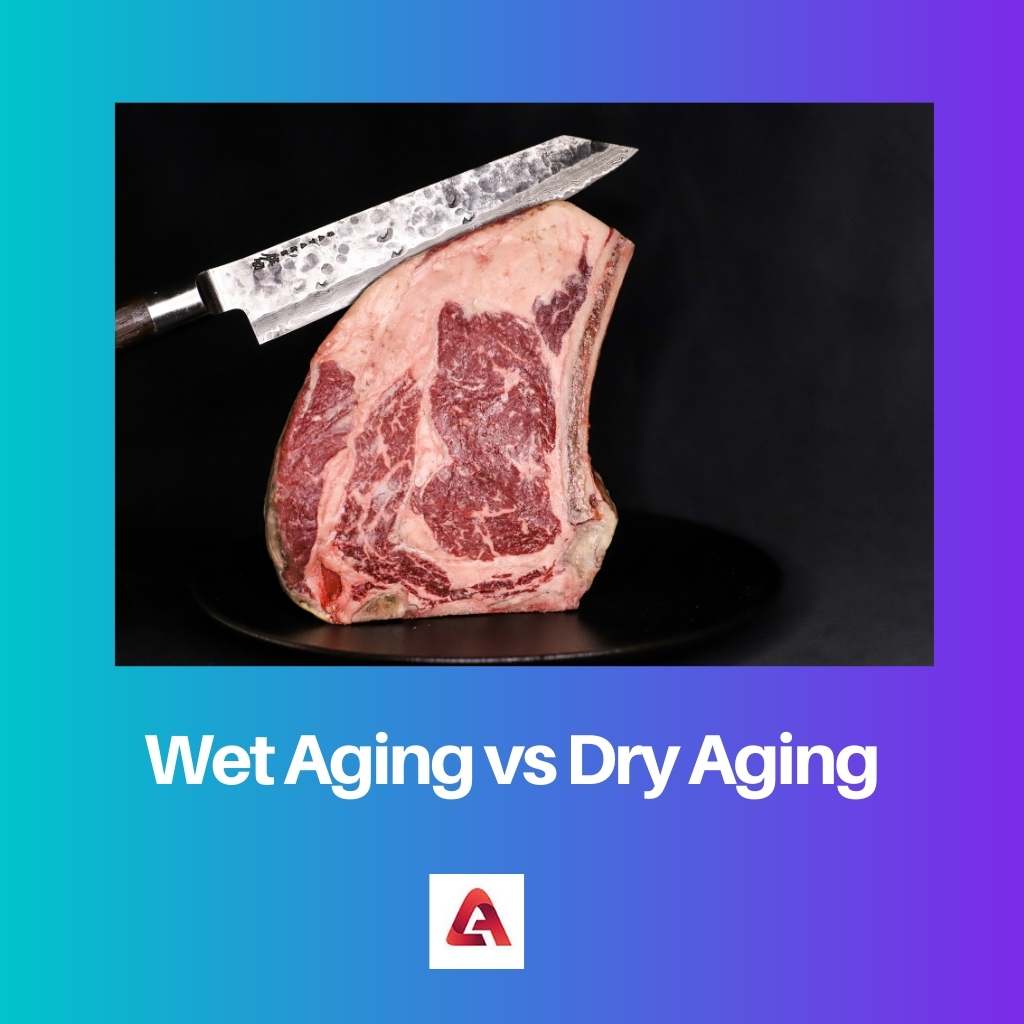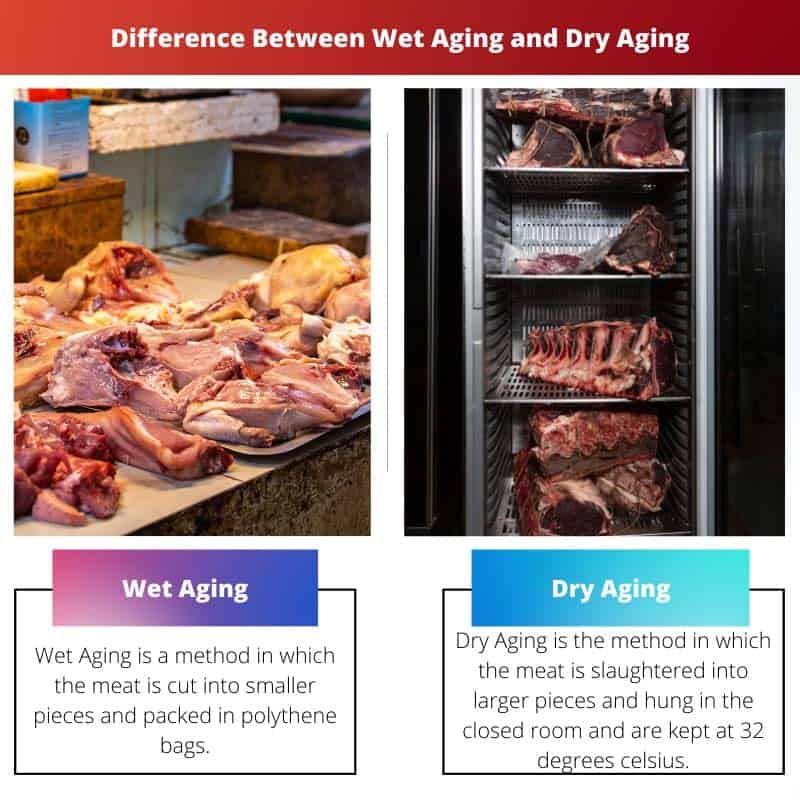The non-veg has been the favorite part of someone’s food. Everyone has different types of preferences for meats. Someones love dry meat, while some need juicy meat.
The difference in meat preference does not make us wired. Many people in this world prefer juicy meat steaks.
But the juicy meats also come in two different categories, and customers have to decide between two different types of beef: Wet and Dry.
Key Takeaways
- Wet aging involves storing meat in vacuum-sealed packaging, while dry aging involves hanging meat in a controlled environment.
- Wet aging is faster and less expensive than dry aging but produces less intense flavor and texture.
- Dry aging is more expensive and time-consuming than wet aging, producing a more intense flavor and tender texture.
Wet Aging vs Dry Aging
The difference between Wet and Dry Aging is that they have different preservation methods.
Wet Aging is the modern-day method that includes meat Aging by the juices of the meat themselves in a vacuum.
While Dry Aging is an old method, in this, the large meat pieces or the whole animal is hung inside a room maintained at 32 degrees Celius temperature.

Wet Aging is the process that is the present-day method. In this process, small pieces of meat are packed inside the polythene bags. The meat pieces are packed when they are slaughtered.
This avoids the contact of meat with the air. The vacuum avoids its contact.
Thus, the meat juices themselves age the meats and make them juicy. This also maintains their quality along with the uh increased shelf life.
Dry Aging is the old method used to store meats. This method included the animal being slaughtered, and large pieces of the whole animal’s flesh were hung in a closed room.
The pieces can also be kept on porous shelves. The temperature of the room is maintained at 32 degrees Celsius.
The Dry Aging required monitoring to see if any meat was not rotten.
Comparison Table
| Parameters of Comparison | Wet Aging | Dry Aging |
|---|---|---|
| Definition | Wet Aging is a method in which the meat is cut into smaller pieces and packed in polythene bags. | Dry Aging is the method in which the meat is slaughtered into larger pieces and hung in the closed room and are kept at 32 degrees celsius. |
| Taste | The meats are dry and thus meats lose their flavors. | The Dry Aging meat is better in flavor and texture as compared to the Wet Aging meat. |
| Process | The process of Wet Aging includes the vacuum which avoids contact with the air thus reducing the oxidation of meat. The Wet Aging of meats increases their shelf period. | Dry aging is the process that takes place in a closed room and the meat is kept into larger pieces either hung or kept on shelves. |
| Shelf Life | It has more shelf life as compared to Dry Aging. | The meat has less shelf period as compared to the Wet Aging meat. |
| Temperature | The temperature required in this process is 2.2 degrees celsius. | The temperature mounted in the process is 32 degrees celsius. |
| Cost | Wet Aging is a cost-effective and easy process. | Wet Aging is expensive as the slaughtered meat can get rotten which leads to loss. |
What is Wet Aging?
Wet Aging is the method of preserving meat. This is the modern-day technique in which we use the vacuum to preserve meat. The meat is cut into small pieces and packed into polyethylene.
The polythene here prevents the oxidation of the meat, and thus, the meat is avoided from getting spoiled. This method is also useful for storing meat on a large loan scale.
The Wet Aging method requires a refrigerator as the storing temperature of meats is 2.2 degrees Celsius. The meat can be stored for a long time as the meat is prevented from direct contact with the air, which reduces the rancidity of the meat.
This increases the shelf period of the meat.
The Wet Aging method is cheap and easy as compared to Dry Aging. This method is reliable, and also the wastage of meat is decreased.
Whereas the texture is somewhere saved, the taste of the Wet Aging yet is not so perfect. The meat is dry as the water gets evaporated on heating.
The method is widely used in industries to store threat and transport it.
What is Dry Aging?
Dry Aging is the ancient method of storing meats. In this process, the meats are slaughtered and hung in the room, or they can also be kept on the shelf, which has pores.
The room is closed, and the temperature of the room s 32 degrees Celsius. This method needs monitoring as the meats can also get rotten if the temperature varies even by a degree.
In Dry Aging, the meat is cut into pieces, and the meat juices and air are present in the room. Allow the Aging of the meat to slowly.
The method includes somewhere the natural way of Aging. Thus, the fat of the meat itself gets degraded, and then the bonds break, hence the meat’s aging takes place.
This is the reason because of why they all require monitoring.
Dry Aging is the method in which the meat does not lose its natural taste and texture. The meat is juicy and rich in flavor.
The only limitation was that the meat shelf life is less as compared to the Wet Aging meat. The method is also costly as the meat gets rotten and is not sold or eaten.
Main Differences Between Wet Aging and Dry Aging
- Wet Aging is a modern-day technique, whereas Dry Aging is an ancient technique.
- Wet Aging is the method in which the meat juices help in the Aging of meat, whereas the Dry Aging method includes the air in the room.
- The Wet Aging temperature is 2.2 degrees Celsius, while the Dry Aging temperature is 32 degrees Celsius.
- Wet Aging is cost-efficient, whereas Dry Aging has led to many losses.
- Wet Aging increases the shelf life of the meat, while Dry Aging meat can be stored for less time.
- Wet Aging reduces the taste of the meat, whereas Dry Aging meat is very rich in taste and texture both.

- https://janimscitechnol.biomedcentral.com/articles/10.1186/s40781-016-0101-9
- https://www.sciencedirect.com/science/article/pii/S0309174007003324

All the science behind this is interesting, but it ultimately comes down to personal preference. The type of aging is secondary to one’s own taste.
This is highly interesting and informative. The science behind meat preservation never occurred to me.
I disagree, dry aging might be costlier and time-consuming, but I think it’s worth it for the superior flavor and texture. Quality over quantity, I’d say.
Wet aging, dry aging; it just sounds like a fancy excuse for leaving meat lying around for longer than necessary.
I never knew there was so much to meat aging processes, a highly educational read.
Ah, the age-old debate of dry versus wet aging. It’s like choosing between fine wine and mass-produced alcohol.
You make a compelling argument, James. In the end, it’s all about what you enjoy on your plate.
As a vegetarian, I must say, the differences are fascinating.
I don’t see the point of dry aging when wet aging is more efficient. Wet aging is the undisputed winner.